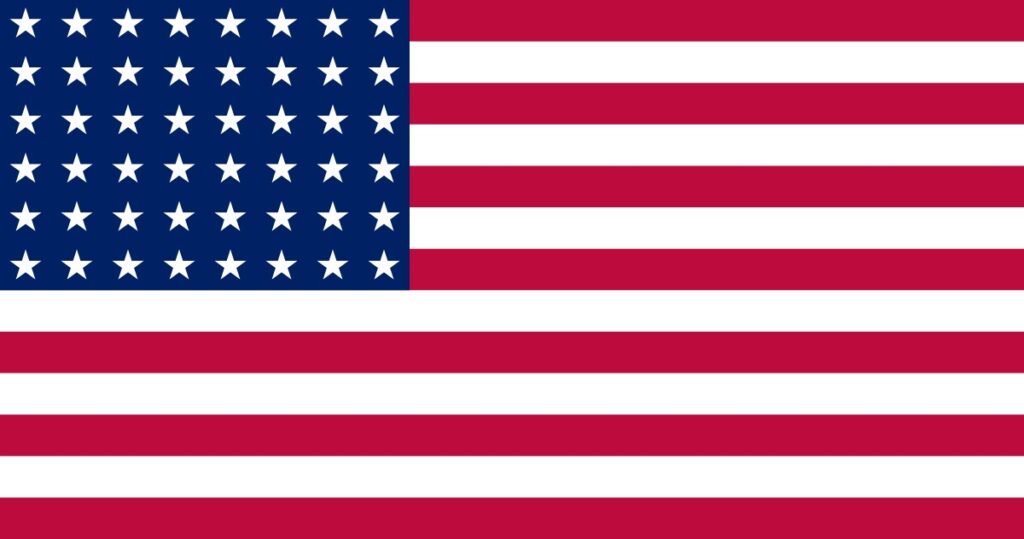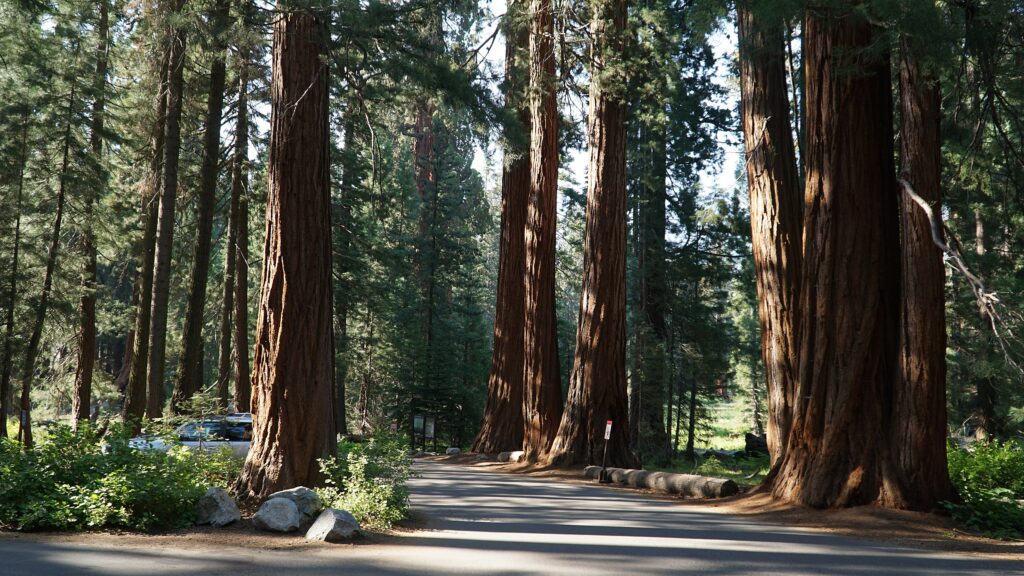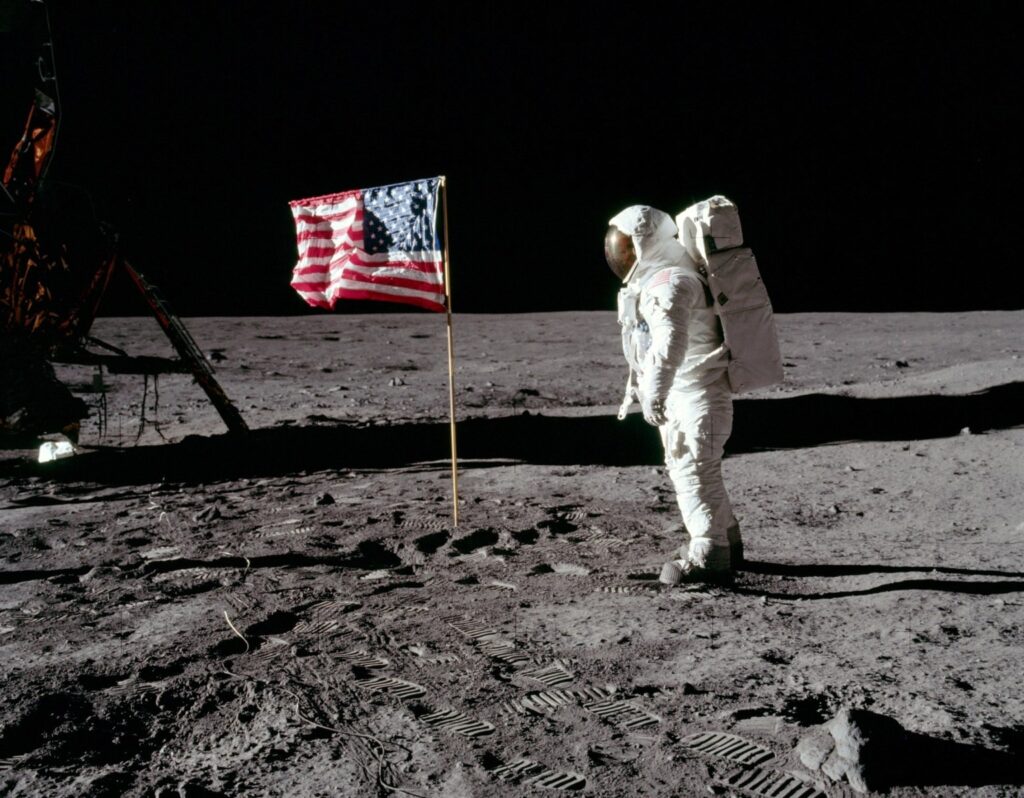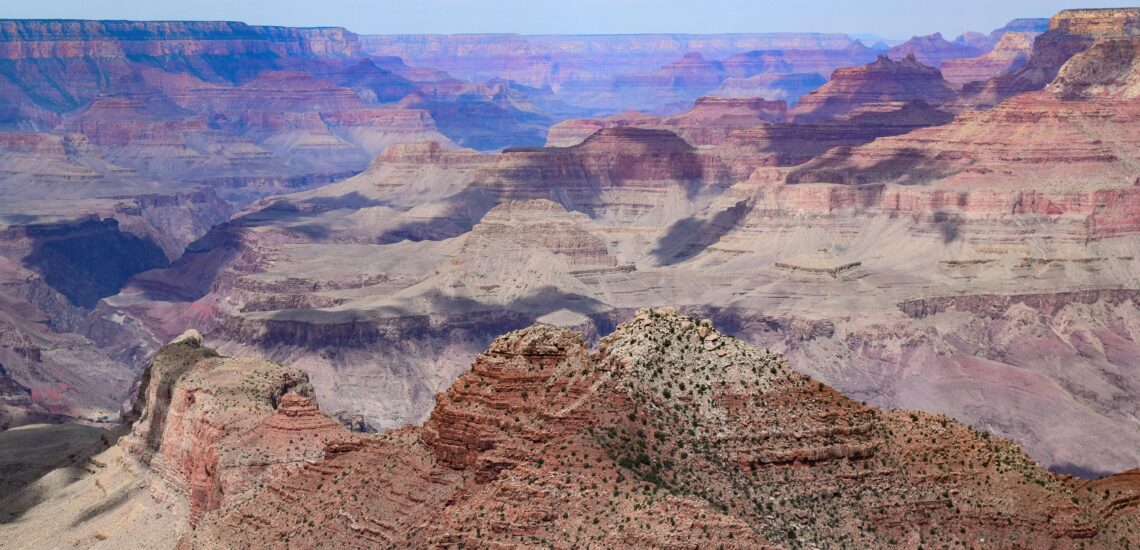Fatos rápidos sobre os EUA:
- População: Aproximadamente 333 milhões de pessoas.
- Capital: Washington, D.C.
- Idioma oficial: nenhum em nível federal, mas o inglês é a língua mais falada.
- Moeda: Dólar dos Estados Unidos (USD).
- Governo: República constitucional presidencial federal.
- Religião principal: Cristianismo, com uma gama diversificada de denominações, incluindo protestantismo, catolicismo e outras religiões.
- Geografia: Localizada na América do Norte, faz fronteira com o Canadá ao norte e o México ao sul, com o Oceano Atlântico a leste e o Oceano Pacífico a oeste.
Fato 1: O desenho da bandeira dos EUA variou dependendo do número de estados
A bandeira dos EUA, muitas vezes chamada de “Estrelas e listras”, apresenta um campo de 13 faixas vermelhas e brancas alternadas representando as 13 colônias originais que declararam independência da Grã-Bretanha em 1776. No canto superior esquerdo, ou cantão, há um campo azul, conhecido como união, contendo um número variável de estrelas brancas, cada uma representando um estado da União.
À medida que os Estados Unidos se expandiram territorialmente e admitiram novos estados na União, o número de estrelas na bandeira aumentou proporcionalmente. O desenho da bandeira foi padronizado pela Ordem Executiva do Presidente William Howard Taft em 24 de junho de 1912, especificando que as estrelas fossem dispostas em fileiras e escalonadas de forma a criar um padrão simétrico. O desenho atual da bandeira com 50 estrelas representando os 50 estados está em uso desde 4 de julho de 1960, após a admissão do Havaí como o 50º estado.
Antes de 1912, havia variações na disposição das estrelas na bandeira à medida que novos estados eram admitidos. Por exemplo, durante a era da Guerra Civil, os desenhos das bandeiras podiam apresentar configurações com estrelas dispostas em círculos, linhas ou outros padrões. No entanto, desde a emissão da ordem de padronização em 1912, o desenho da bandeira dos EUA permaneceu consistente, com estrelas dispostas em fileiras horizontais..

Fato 2: Os EUA ainda não adotaram o sistema métrico de medição
Os Estados Unidos usam principalmente o sistema de medição habitual, que inclui unidades como polegadas, pés, libras e galões, para fins diários, como comércio, construção e transporte. No entanto, o sistema métrico, que usa unidades como metros, quilogramas e litros, é comumente empregado em contextos científicos, médicos e internacionais.
Os esforços para promover a métrica, ou a adoção do sistema métrico, nos Estados Unidos estão em andamento há décadas. Em 1975, a Lei de Conversão Métrica foi sancionada, com o objetivo de incentivar a adoção voluntária do sistema métrico nos EUA. No entanto, o progresso em direção à métrica tem sido lento e inconsistente, e o sistema habitual continua prevalecente em muitos aspectos da vida americana.
Como resultado, os Estados Unidos continuam sendo um dos poucos países em todo o mundo que não fez a transição completa para o sistema métrico como seu principal sistema de medição.
Fato 3: Devido ao seu tamanho, os EUA têm muitas zonas climáticas
Os Estados Unidos são o terceiro maior país do mundo em área terrestre, abrangendo uma ampla variedade de latitudes e extensões longitudinais. Como resultado, ele experimenta uma variedade de climas, desde condições árticas no Alasca até climas tropicais no Havaí e nas regiões mais ao sul da Flórida. Algumas das principais zonas climáticas encontradas nos Estados Unidos contíguos incluem:
- Continental temperado: Esta zona climática cobre grande parte das porções central e oriental do país, caracterizada por quatro estações distintas com verões quentes a quentes e invernos frios. Cidades como Nova York, Chicago e Minneapolis se enquadram nessa zona.
- Subtropical úmido: encontrada no sudeste dos Estados Unidos, essa zona climática apresenta verões quentes e úmidos e invernos amenos, com chuvas abundantes durante todo o ano. Cidades como Atlanta, Nova Orleans e Miami experimentam esse clima.
- Mediterrâneo: Localizada ao longo da costa oeste, da Califórnia a partes do Oregon e Washington, essa zona climática é caracterizada por verões secos e quentes e invernos amenos e úmidos. Cidades como Los Angeles, San Francisco e San Diego se enquadram nessa zona.
- Árido e semiárido: essas zonas climáticas cobrem grandes porções do oeste dos Estados Unidos, incluindo partes da Grande Bacia, do Sudoeste e das Montanhas Rochosas. Eles são caracterizados por baixa precipitação, altas temperaturas e grandes variações de temperatura entre o dia e a noite. Cidades como Phoenix, Las Vegas e Albuquerque têm climas áridos ou semiáridos.
- Continental: Esta zona climática abrange o norte das Grandes Planícies e o Alto Centro-Oeste, caracterizada por invernos frios com fortes nevascas e verões quentes a quentes. Cidades como Minneapolis, Denver e Fargo experimentam climas continentais.

Fato 4: Califórnia e Texas têm economias maiores do que a maioria do país
A economia da Califórnia é a quinta maior do mundo, com um Produto Interno Bruto (PIB) de mais de 3 trilhões de dólares. As diversas indústrias do estado incluem tecnologia, entretenimento, agricultura, manufatura e turismo. O Texas segue logo atrás, com uma economia que ocupa a nona posição global e um PIB superior a 1,7 trilhão de dólares. Os principais setores do Texas incluem energia, manufatura, saúde, tecnologia e agricultura. Juntos, esses dois estados contribuem significativamente para a força econômica dos Estados Unidos, impulsionando a inovação, a criação de empregos e o crescimento em escala nacional.
Fato 5: A montanha mais alta da América do Norte está localizada no Alasca
O Monte Denali é o pico mais alto da América do Norte, com uma elevação de 20.310 pés (6.190 metros) acima do nível do mar. Ele está situado na Cordilheira do Alasca, dentro do Parque e Reserva Nacional Denali, aproximadamente 240 milhas (386 quilômetros) ao norte de Anchorage, a maior cidade do Alasca. O Monte Denali é uma característica proeminente da paisagem do Alasca e é conhecido por suas desafiadoras rotas de escalada e beleza natural deslumbrante. Ela atrai alpinistas e entusiastas de atividades ao ar livre de todo o mundo que buscam atingir seu pico elevado e conhecer a natureza selvagem do Alasca.

Fato 6: A idade legal para beber nos EUA é 21 anos
Nos Estados Unidos, a idade legal para beber é fixada em 21 anos por lei federal. Isso significa que os indivíduos devem ter pelo menos 21 anos de idade para comprar e consumir bebidas alcoólicas.
Também existe um alto limite de idade para aluguel de carros aqui na maioria dos estados. Essa exigência de idade é baseada em dados estatísticos que sugerem que motoristas mais jovens, especialmente aqueles com menos de 25 anos, têm maior probabilidade de se envolver em acidentes de carro. No entanto, algumas locadoras podem permitir que pessoas entre 21 e 24 anos aluguem um carro, mas elas podem estar sujeitas a taxas ou restrições adicionais, como tarifas de aluguel mais altas ou cobertura de seguro obrigatória.
Nota: Verifique também se você pode precisar de uma carteira de motorista internacional nos EUA. Você pode ler sobre como obter uma Permissão Internacional para Dirigir aqui, mas é melhor obter uma no país onde você obteve sua carteira de motorista.
Fato 7: Existem mais de 400 parques nacionais e mais de 2.000 outras áreas protegidas nos Estados Unidos
Os Estados Unidos abrigam um vasto e diversificado sistema de áreas protegidas, incluindo parques nacionais, florestas nacionais, monumentos nacionais, refúgios de vida selvagem, áreas selvagens e muito mais. De acordo com os dados mais recentes, existem mais de 400 unidades no Sistema Nacional de Parques, que inclui parques nacionais, monumentos, locais históricos, áreas de recreação e outras designações administradas pelo Serviço Nacional de Parques.
Além dos parques nacionais, existem milhares de outras áreas protegidas em todo o país, incluindo parques estaduais, áreas de conservação, áreas de manejo da vida selvagem e parques locais. Essas áreas desempenham um papel crucial na preservação da biodiversidade, na proteção dos recursos naturais e culturais e no fornecimento de oportunidades recreativas para os visitantes.

Fato 8: A maioria da população dos EUA reside ao longo das costas leste e oeste
As costas leste e oeste dos Estados Unidos abrigam algumas das regiões mais densamente povoadas do país. Na costa leste, grandes áreas metropolitanas, como Nova York, Boston, Filadélfia e Miami, atraem grandes populações. Da mesma forma, a costa oeste, particularmente em estados como Califórnia e Washington, é caracterizada por cidades movimentadas como Los Angeles, San Francisco, Seattle e San Diego.
Essa concentração da população ao longo das costas é influenciada por vários fatores, incluindo padrões históricos de assentamento, oportunidades econômicas, infraestrutura de transporte e características geográficas. As áreas costeiras geralmente oferecem acesso a portos, rotas comerciais e amenidades costeiras, tornando-as lugares atraentes para morar e trabalhar.
Fato 9: Os americanos ainda são as únicas pessoas que estiveram na lua
O programa Apollo dos Estados Unidos, particularmente a missão Apollo 11, fez história em 20 de julho de 1969, quando os astronautas Neil Armstrong e Edwin “Buzz” Aldrin se tornaram os primeiros humanos a pisar na superfície lunar. Armstrong proferiu as famosas palavras: “Esse é um pequeno passo para [um] homem, um salto gigante para a humanidade”, ao descer a escada do módulo lunar até a superfície da lua.
Posteriormente, mais cinco missões Apollo (Apollos 12, 14, 15, 16 e 17) pousaram astronautas na lua com sucesso entre 1969 e 1972. No total, doze astronautas, todos americanos, caminharam na lua durante essas missões.
Nenhum outro país ou agência espacial conseguiu pousar astronautas na Lua desde o programa Apollo. No entanto, existem esforços e planos de vários países, incluindo os Estados Unidos, para devolver astronautas à Lua em um futuro próximo, como parte de missões científicas e de exploração.

Fato 10: Há um grande número de povos indígenas nos EUA
Antes da colonização europeia, a área agora conhecida como Estados Unidos era habitada por uma grande variedade de povos indígenas, cada um com suas próprias culturas, línguas e tradições. Esses grupos indígenas incluíam, entre outros, os Navajo, Cherokee, Sioux, Apache, Iroquois e Choctaw, bem como várias tribos e bandos menores.
Hoje, existem mais de 570 tribos reconhecidas pelo governo federal nos Estados Unidos, cada uma com seu próprio governo soberano e uma herança cultural distinta. Além disso, existem tribos reconhecidas pelo estado e outras comunidades indígenas que podem não ter reconhecimento federal. Esses povos indígenas continuam a desempenhar papéis importantes na vida cultural, social e política dos Estados Unidos, e os esforços para preservar e revitalizar suas culturas e idiomas estão em andamento.
É importante notar que a população indígena dos Estados Unidos sofreu muito devido a doenças, deslocamentos e violência após o contato com a Europa, resultando em declínios populacionais significativos. No entanto, muitas comunidades indígenas perseveraram e continuam mantendo suas identidades culturais e modos de vida tradicionais.

Publicado Abril 27, 2024 • 9m de leitura





